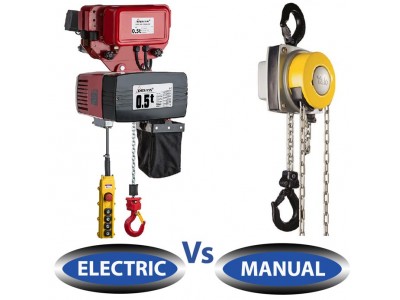When it comes to deciding whether an electric hoist or manual hoist would be best suited to your requirements there are many considerations to look in to. It is important to choose the hoist based on where and how it needs to be used. Choosing the wrong hoist can be a costly mistake!

Deciding on an Electric Hoist or Manual Hoist
Some Basic things to consider
- Where will the hoist be used? Is there a suitable suspension point?
- How will it be used and the frequency?
- Does the hoist need to move along a beam? A beam trolley will be needed.
- Do you need a power supply? Is the right type available?
- What type of loads will you be lifting? Think about the weights to determine the hoists lifting capacity.
- Do you need to use the hoist in multiple locations? Manual hoists can be moved from place to place more easily.
- Is lifting speed important? Some electric types can be found with dual speeds for precision and speed. The speed of a manual type will depend on the user, typically much slower.
- Do you need a hoist that needs no physical effort? If so an electric hoist will probably be better suited. Manual hoists need physical effort and some strength.
- What is your budget? Manual hoists are usually much cheaper then its electric counterpart.
- Think about upkeep, maintenance and repair costs.
- Electric Hoist and Manual Hoist Pro’s and Con’s
- Here are some basic pro’s and con’s for each type of hoist at a glance for easy comparison.
Electric Hoist or Manual Hoists The pro’s & Con’s
Here are some basic pro’s and con’s for each type of hoist at a glance for easy comparison.
| ELECTRIC HOIST PRO’S | MANUAL HOIST PRO’S |
| Quicker lifting for optimum efficiency | Cheaper outlay |
| No physical effort required | No power supply required |
| Single or dual speed options | Single or dual speed options, Easy transportation |
| Lifting at the touch of a button | Easier to use in multiple locations |
| Lift and lower with speed | Typically easier and cheaper to repair |
| Minimises physical injuries | No running costs |
| Ideal for frequent lifting tasks | Simple design, less likely to have issues |
| Increases productivity | Lighter in weight |
| Can be operated at a distance (out of harms way) | Precision lifting and landing of loads |
| Radio control options | Easy maintenance |
| ELECTRIC HOIST CON’S | MANUAL HOIST CON’S |
| More costly outlay | Physical effort needed, can be hard work |
| Harder to transport and move around | Can cause physical strains and fatigue |
| Typically more costly repairs/spares | Slower lifting |
| Cost more to run (electricity use) | Need to be next to hoist to operate |
| Need the correct electric power supply |
Conclusion
When the above considerations as well as the pro’s and cons are consolidated it is easy to see that there is good and bad for both types of lifting hoist. Therefore the ultimate decision will depend on your circumstances.
If you are still undecided then speak to the experts who will guide you according to your lifting operations and set up. It is also worth noting that whichever type you go for there is a huge amount of choice, from brands to model options right down to the product specifications.
If you would like this choice made easier then the Lifting Gear Store is the place to go. There are just a few products in each type to choose from, hand picked by their experienced team. So whether you want an electric hoist (our Delta model is a great buy) or manual hoist such as a chain block or lever hoist we can help. Buy online or call us on 01384 76961 for help, advice, quotations or ordering.




